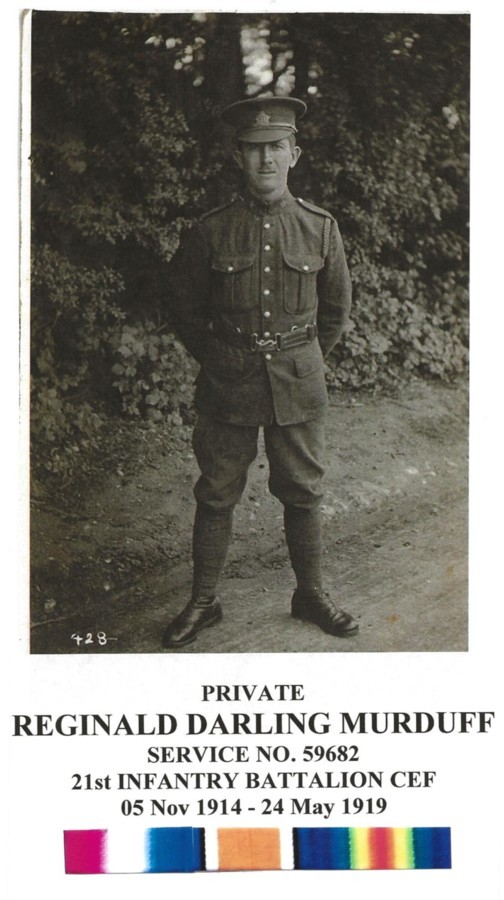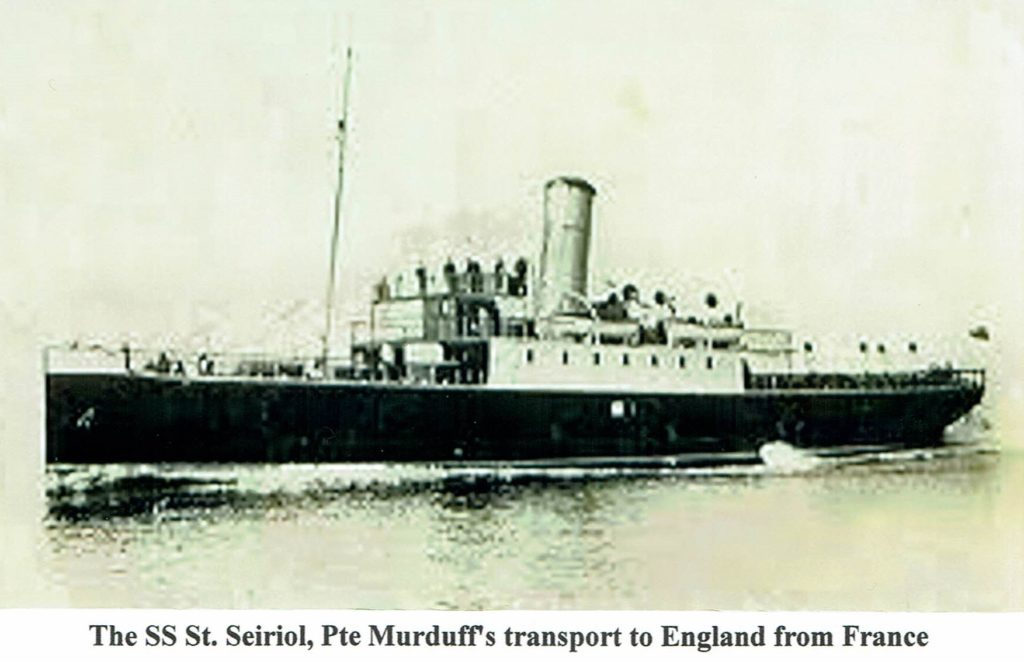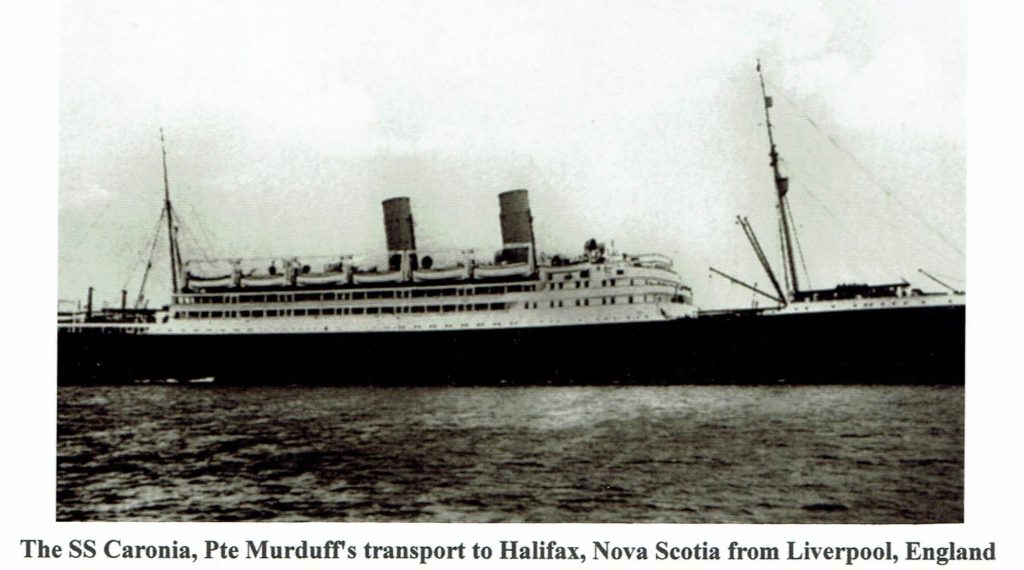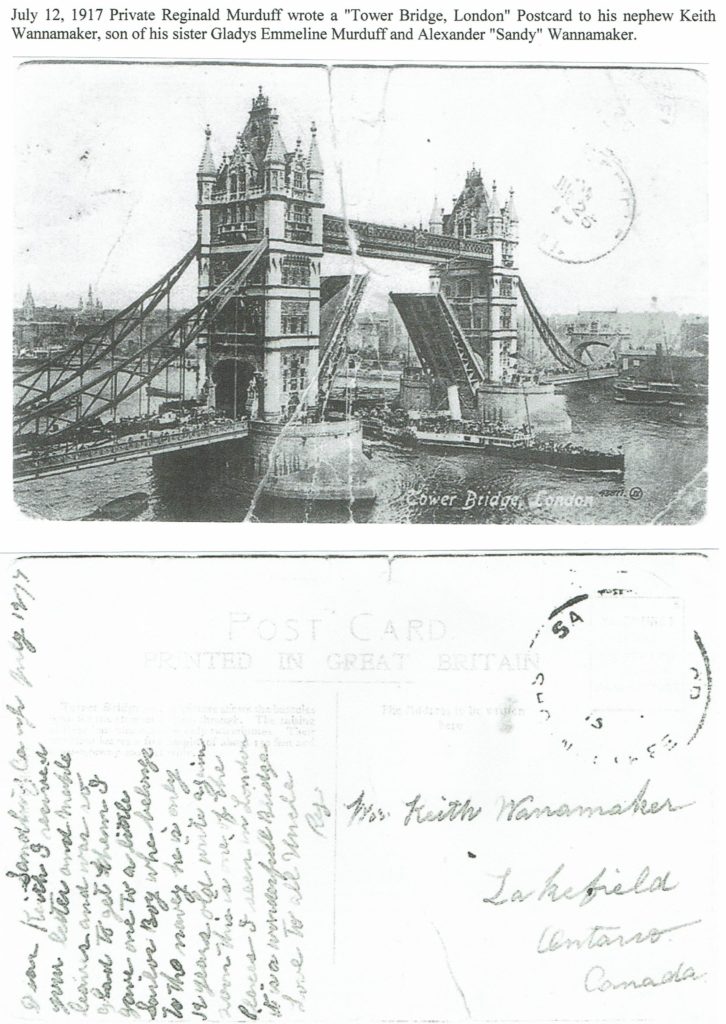MILITARY HISTORY
Private Reginald Darling Murduff – 59682 — ACTIVE SERVICE (World War I)
On November 5, 1914 Reginald Darling Murduff completed the Attestation Paper for the Canadian Army Canadian Expeditionary Force (CEF). He was 32 years, 11 months old when, as a single man, he enlisted for the duration of the War. Reginald Darling was born in Lakefield, Ontario and gave his birth-date as March 28, 1882. He indicated that he did not presently belong to a Militia Force and had no previous Military experience. There is nothing on Reginald Darling’s File to indicate where he was educated or to what level. As far as his Trade or Calling is concerned, he lists Boat Builder. Reginald Darling was 5′ 4½” tall, with a 33” chest (expanded). There is no indication of his weight. He had a dark complexion with brown eyes and black hair. Reginald Darling’s Medical Examination was completed January 5, 1915 in Kingston, Ontario. Other than a few small scars he had no medical issues or physical limitations; he was deemed fit for Overseas duty with the CEF. His next-of-kin was listed as his father, Mr. George Murduff of Lakefield, Ontario. Reginald Darling Murduff signed the Oath and Certificate of Attestation on January 5, 1915 in Kingston, Ontario. He was taken-on-strength with the 21st Battalion (Bn) as a Private (Pte) and was assigned Service Number 59682.
Of interest is that the Certificate of Magistrate was signed by the Justice on November 5, 1914, and Pte Murduff signed the Attestation Paper on January 5, 1915. His Discharge Certificate has his tour of duty starting on November 5, 1914.
There is no reference in Pte Murduff’s File as to where the 21st Battalion trained but based on the dates it was more than likely at Valcartier, Québec. Valcartier was erected as a Military Training Base, in August 1914, as part of the mobilization of the Canadian Expeditionary Force, at the outset of World War I. The Base is located approximately 16 miles north of Québec City. In the beginning the facilities and training were pretty rudimentary. Training consisted of marching, rifle and bayonet drills. The Officers were trained in the correct use of a pistol and practiced swordmanship. The main goal was to form the men in Units and ship them off to England, as quickly as possible, where they would complete their training.
Pte Murduff and the 21st Bn embarked from Montréal, Québec on May 6, 1915, aboard the SS Metagama.
Pte Murduff and the 21st Battalion disembarked at Devonport, England on May 15, 1915 and proceeded to West Sandling, near Hythe, in Kent County, England. Over the next four months the 21st Bn would conduct a lot of training in all aspects required to confront the enemy and instill discipline.
The War Diary of the 21st Canadian Infantry Battalion indicates the following for this period of time.
Pte Murduff and the 21st Battalion (Bn) embarked from Folkestone, England for France aboard the St. Seiriol, on September 14, 1915, but halfway across the English Channel they were turned back by Naval Authorities. They sailed the following morning arriving at Boulogne, France, around midday, on September 15, 1915.
After a day’s halt at a Rest Camp, they entrained for St. Omer. On the 16th, they marched to Raisbrook, where they rested before moving on to Eecke on the 17th, and on to Dranoutre on the 18th. On the 19th, the 21st Bn took up positions in the trenches, where they stayed until they were relieved on the 27th, moving to billets at Dranoutre. On October 3rd, they were back in the trenches. On the 9th, the Bn was back in billets at La Cylette. October 27th, the Bn moved back to the trenches.
The File indicates, ”On October 27, 1915 Pte Murduff was wounded when in a trench near Dicky Bush, he was shot in the right leg, below the knee, by a sniper”. There is a reference in the 21st Bn War Diary that there was ”one casualty”, on this day. Dickebusch is a Village located in Ypres Salient, Belgium. He was first taken to a Canadian Field Ambulance, then to the 25th General Hospital at Étaples.
On November 15, 1915 he left Étaples for Le Havre, sailed for Southhampton on November 16, 1915 arriving on November 17, 1915. He was taken to the Duchess of Connaught Canadian Red Cross Hospital, at Taplow, England the same day. Pte Murduff was taken-on-strength with the 39th Battalion, at West Sandling, England on November 17, 1915. While at West Sandling, he was examined. The assessment was: ”General condition good. All systems examined and found apparently normal. Local Exam – apparently only a flesh wound, although it seems scarcely possible the bone was not touched. Each wound about the size of a ten cent piece. Clean and healing”. November 21, 1915 Murduff was examined once again. ”No discharge, nearly healed. Can walk about. Complains of knee being weak, and says when being carried out of the trench, on a stretcher, the bearers dropped him, and he struck his knee on a piece of iron. Did not trouble him at the time. No swelling at present but is tender”. November 29, 1915 ”wounds healed, walks with slight limp”.
On January 16, 1916 Pte Murduff was transferred to the Hillingdon Convalescent Hospital, at Uxbridge, England. On January 24, 1916 he was discharged to the Reserve Unit. March 8, 1916 he was examined at West Sandling. Physical Exam – Negative. He was declared: ”Fit for light Duty – 10 weeks”. June 4, 1916 Pte Murduff was taken-on-strength with a Canadian Casualty Assembly Centre. July 12, 1916 he was examined. His condition was listed as ”walks with slight limp, no restriction of joint movement”. He was declared: ”Fit for Duty after 4 weeks physical training at Monks Horton”. On September 17, 1916 Pte Murduff was ”attached to 11th Bn from 39th Bn, at Shorncliffe”. September 27, 1916 he was transferred to the 21st Battalion Overseas. On the same day, he arrived at and was taken-on-strength at the Canadian Base Depot, Le Havre, France. October 12, 1916 he left for his Unit and joined the 21st Bn on October 14, 1916.
On November 5, 1916 Pte Murduff was awarded the Good Conduct Badge. There are no entries in the File from November 5, 1916 and November 15, 1917
The War Diary of the 21st Canadian Infantry Battalion indicates the following for this period of time.
From November 5, to December 31st, 1916 the 21st Bn made a series of moves to and from the Front-Line relieving the 19th Bn, and in-turn being relieved by the 19th Bn.
January 1917 – begins with the 21st Bn in Divisional Reserve billets at Bully Grenay. On January 3rd, it moved to the Front-Line. January 7th, the Bn was relieved and proceeded to Bully Grenay for ”special training”. On January 17th, at 5:00 AM, the 21st Bn proceeds to take up positions on the Front-Line, and prepares for an assault on enemy positions. ”At 7:45 AM, the Artillery opens fire and the first wave of the assault goes over the top, followed by two more waves. By 8:30 AM the enemy line was evacuated and the Bn returned to its own line after causing tremendous damage to enemy line and inflecting heavy casualties. During the assault numerous prisoners were taken”. Battalion casualties were: 1 Officer wounded, 11 other ranks killed, and 61 wounded. Later on the 17th, the 21st Bn withdrew to Brigade Reserve position at Calonne, where it spent the 18th and 19th, resting and cleaning up. On January 20th, it proceeded to a Divisional Reserve position at Bully Grenay. On January 21st, the Battalion marched to the Ruitz Training area, where it stayed until January 30th, when it marched to billets in Marles Les Mines.
February 1917 – began with the 21st Bn still in the area of Marles Les Mines, where they undertook ”special training”. On the 13th, it marched to new huts at Ruitz. On the 14th, they moved to C2 Sub Sector of the Front-Line in the Thelus area. The remainder of February, was fairly active, in the trenches, but with very few casualties. A mention is made that on one day: ”30 Fish-tails were fired into the trenches”. Fish-tails was trench slang for German trench mortar shell 8” long, corrugated, with a hollow stem which slips over the gun barrel, when it is fired. It had fish-tail shaped fins, thus the name.
March 1917 – the 21st Bn was relieved on the Front-Line and proceeded to billets at Bois des Alleux, where it formed the Divisional Reserve. March 9th, the Bn moved forward to a Brigade Support position. It was reported: ”the trenches are in terrible shape. In places the mud is knee deep”. The next week was spent improving the conditions in the trenches. March 15th, the Bn was relieved and it moved to the area of Bois des Alleux. On March 20th, it was moved to a Brigade Reserve position in the area of Bois des Aeris. On the 24th, it was relieved and moved to billets in the rear. The time between March 26th and 31st was spent: ”undergoing strenuous training, such as Platoon and Company in Attack, physical drills, bombing etc”. It is noted: ”during this time period, the weather remained very bad, raining most of the time”.
April 1917 – began with the 21st Bn still in the rear undergoing ”special training”. On April 4th, the Bn started movement towards the trenches in the Thelus Sector. Through the 5th to 7th, it continued ”special training”. During the afternoon of April 8th, it moved to the St. Eloy, followed by a move to the jumping off trenches in the evening. By 4:00 AM, the morning of April 9th, the Bn was in position for the start of the Battle of Vimy Ridge. At Zero Hour 5:30 AM, the Bn went over the top, following a creeping Artillery barrage, and quickly advanced toward the enemy trenches. By Zero Hour plus 105 minutes, all objectives had been captured. The War Diary states: ”Enemy machine guns and trench mortars were the chief resistance encountered. Enemy wire was conspicuous in its absence. Our Artillery had completely demolished it. Further evidence of our Artillery effectiveness was the state of the Hun trenches, with only the outlines remaining”. During this short period of time: 10 Officers were either killed, wounded or missing. 205 other ranks suffered the same fate. By Zero Hour plus two hours, the 21st Bn was at Ulmer Haus, where they spent the remainder of the day resting, reorganizing, and re-equipping. It is stated: ”the special training the Canadian Battalions went through prior to the attack, played a great role in the success of the the day”. On the 10th, the Bn relieved another Bn in the area of Cramer Haus. The next 3 days were relatively quiet. On April 14th, the 21st Bn was relieved, and proceeded to Bois des Alleux, where their time was spent reorganizing and re-equipping. The Bn remained in this position until April 23rd, when it moved back to the Front-Line trenches. On the 26th, it was relieved and proceeded to the Brigade Camp at Aux Rietz Corners, where it stayed until April 29th. On the 29th, it proceeded to Chateau de Acq, where everyone had a bath, and attended a Church Service.
May 1917 – on the 1st, the 21st Bn was inspected by Brigadier General Rennie, everything looked fine. From the 1st to the 6th, everyone was enjoying the fine weather. On May 6th, the Bn moved to the Observation Line. On the 7th, the Bn moved to the 3rd Line (railway embankment) Thelus Cave area, where the Unit experienced a heavy shelling overnight with gas shells causing many casualties – two of which were fatal. On the 8th, the Bn moved to forward area, where the enemy was very active with gas shells, but no casualties. Through the 9th and 10th of May, the enemy made two attempts to attack Bn positions, but were driven back by Artillery barrages. On 11th and 12th, there were sporadic and short enemy barrages, which caused few casualties. On May 13th, the Bn proceeded to Divisional Rest area at Aux Rietz. The Bn remained in this area until May 29th, resting – cleaning up and undergoing an inspection by the Corps Commander. On the 29th, it was back to the Front-line trenches in the left Sub Sector. Everything was quiet for the rest of the month.
June 1917 – the 21st Bn was ordered to take up positions in Paynesley – Neuville St. Yaast area. On the 2nd, it proceeded to the Divisional Rest area at Aux Rietz. On the 3rd, it moved to the Barlin Training area, near Coupigny. It would remain in this area until the end of the month training in: rifle, bayonet fighting, and bombing. It would also participate in two Sports days. On the 18th, it participated in the Brigade Sports Day, where it did exceptionally well – winning 6 first place prizes, 1 second place prize, and 1 third place prize. On the 23rd, it took part in the Divisional Sports Day.
July 1917 – on July 3rd, the Battalion moved to the area of Bouvigny, and continued its training. On the 7th, it moved to billets in Posse 10 area. On the 10th, it proceeded to Brigade Reserve position in Lens Sector. From the 11th to the 22nd it was in the area of Angres Village. On the 22nd, it proceeded to the Divisional Reserve position at Posse 10, where it enjoyed bathes, and clean clothing. Here it would undertake ”special training and practice attacks”.
August 1917 – was a quiet month for the Battalion. It started the month in a Divisional Reserve position at Posse 10 undertaking light drills. On the 4th, it proceeded to Brigade Reserve position at Bully Grenay, where it participated in physical and respirator drills, bayonet fighting, and fire discipline exercises. On the 11th, it was back to Posse 10. On August 21st, the Battalion moved to billets at Villers au Bois, where it stayed to the end of the month, continuing its training.
September 1917 – was another quiet month for the 21st Battalion. It began with it still at the billets at Villers au Bois. On September 15th, it moved to the Front-Line trenches, where it stayed until the 21st, when it moved back to the billets at Villers au Bois, where it stayed until the end of the month.
October 1917 – began with the 21st Bn still at Villers au Bois. On the 8th, it moved to trenches in the Chaudiere area. On the 11th, it was back a Villers au Bois, where it stayed until October 16th. On the 16th it proceeded to what was described ”as comfortable billets at Ouston”, where it stayed until the 23rd. On the 23rd, it proceeded to Caestre.
November 1917 – from Caestre, it moved on the 2nd to the Potitze area, east of Ypres. On the 5th, it moved to the area south west of Passchendaele, where it setup at Erie camp. It remained in Erie Camp resting and re-equipping. On November 8th, it entrained at Brandhoek, detrained at Ypres and marched to Potitze, where it took up positions on the Front-Line. Overnight of the 9th, it was heavily shelled suffering many casualties. On the 12th, it was relieved and proceeded to the Marles Les Mines area.
On November 15, 1917 Pte Murduff was granted a 10 day Leave, rejoining his Unit on November 25, 1917.
There are no entries in the File from November 25, 1917 to July 5, 1918.
The War Diary of the 21st Canadian Infantry Battalion indicates the following for this period of time.
December 1917 – was another quiet month for the 21st Bn. From the 1st to the 6th, it was stationed at Suburban Camp, near Villers au Bois. On the 7th, it moved to a Brigade Support position at Cellars Camp, near Neuville St. Vaast. From the 13th to the 16th it was in Acheville Section. On December 16th, it proceeded to a Brigade Reserve position near Vancouver Road. December 20th, the Bn marched to Estree Cauchie for billets near Auchy au Bois, where it remained to the end of the month. The month was primarily spent training and in working parties.
January 1918 – the Battalion was still in billets at Auchy au Bois, and continuing ”its usual syllabus of training”. On the 7th, the Bn was inspected by Major General H. E. Burstall, Divisional Commander, 23 Officers and 525 other ranks paraded in ”marching order”. The General expressed his satisfaction with the appearance of the Battalion, and degree of efficiency which had been attained during training. From the 8th to the 11th, the training continued. On the 12th, the 21st Bn paraded in ”fighting order”, along with other Units of the 4th Canadian Infantry Brigade. On the 15th, the Bn marched to Raimbert in pouring rain. Prior to leaving Auchy au Bois, the Bn was voted, by the Villagers, ”as the best behaved Unit that had been billeted in the Village”. On the 18th, the Bn moved to ”Red trench”, at La Coulotte, where they spent the next 5 days, in work parties, improving the trenches. On the 23rd, they moved to the left Sub Sector trenches of the Front-Line. From the 23rd to the 28th, enemy activity was quiet, and the evenings were spent carrying out night patrols in no-mans-land. January 28th, the Bn moved to billets at Chamblain-l’Abbé.
February 1918 – shows the Bn at Hills Camp in Divisional Reserve, in the area of Neuville St. Vaast. On the 8th, it took positions on the Front-Line in the left Sub Section Merricourt Section. Other than the occasional German gas shell fired into the general area, all was quiet. On the 15th, the Bn moved to a Brigade Support position, followed on the 19th to a Divisional Reserve position. On February 28th, it moved to billets in Lieven.
March 1918 – the Bn still in billets at Lievin. On the 3rd, the Bn took up positions on the Front-Line. On the 4th, at 5:54 AM, the Germans sent a large scale raid at the 21st Bn trenches. After stiff fighting, and taking heavy casualties, the enemy raid was beaten back. The day of the 5th was quiet, with little enemy activity, probably as a result of the beating they had taken the day before. On the 6th, the Bn conducted raids against enemy trenches. On the 7th, the Bn was relieved and proceeded to billets in the area of Guy Servins. On the 15th, reinforcements were received, bringing the Bn back up to combat strength. On the 24th the Bn marched back to billets at Hills Camp, Neuville St. Vaast. On the 26th, it marched to Basseux. On the 29th, it moved to a position of close support, North West of Neuville. On the 30th, it moved to the Front-Line.
The 21st Battalion War Diary ends March 31st, 1918.
On July 5, 1918 Pte Murduff was transferred to the Canadian Labour Pool, on being classified B 1. July 6, 1918 he was taken-on-strength with the Canadian Labour Pool, attached on Water Detail. July 7, 1918 was transferred to 21st Battalion on being ”posted to that Unit for duty on Water Detail”. July 8, 1918 he was taken-on-strength with the 21st Battalion, still on Water Detail.
On November 10, 1918 Pte Murduff was granted a 14 day Leave; rejoining his Unit on December 10, 1918; no entries were made to explain why he was 17 days over his period of leave. April 3, 1919 Pte Murduff proceeded to England from the Canadian Embarkation Camp at Le Havre. On May 2, 1919 he was struck-off-strength from the Overseas Military Forces of Canada and was taken-on-strength to the Canadian Expeditionary Force. Private Reginald Murduff embarked from Liverpool, England, on May 14, 1919, bound for Canada, aboard the SS Caronia.
There is no indication, in the File, as to when Pte Murduff arrived in Halifax, but based on other Records it would have been approximately May 24, 1919. He was taken-on-strength with No 3 District Depot, in Kingston, Ontario and was discharged, upon demobilization, from the 21st Battalion on May 24, 1919.
There is no mention in the File with regards to what Military Medals Private Reginald Darling Murduff was eligible to receive or was awarded. Based on his Military Service, he was awarded the:
1914 – 15 Star;
British War Medal; and
Victory Medal.
He would have also received the CEF Class “A” War service Badge.
Based on his Military File, Private Reginald Darling Murduff served a total of 4 years, 6 months, and 3 weeks with the Canadian Expeditionary Force: 6 months in Canada, 1 year, 3 months and 3 weeks in England, and 2 years, 8 months and 1 week in France plus 21 days of travel time.
An excerpt from an article in Maclean’s Magazine by Barbara Ameil, September 1996:
The Military is the single calling in the world with job specifications that include a commitment to die for your country. What could be more honourable?
PERSONAL HISTORY
REGINALD DARLING MURDUFF
Reginald (Reg) Darling was born March 28, 1882 in Lakefield, Ontario to George Murduff and Sarah Jane Darling. He was educated in the Lakefield Public School System and by 1901 both Reg and his father were working at a local sawmill. By 1910 Reg was working for the Lakefield Canoe Company as a boat builder and was a member of the Men’s Lakefield Canoe Company Hockey team.
Reg’s mother, Sarah Jane Murduff, passed away on April 12, 1903 and his father George went to live with his youngest daughter & son-in-law Gladys and Alex Wannamaker and their two boys while Reg went to live with his oldest sister Charlotte “Lottie” and Francis “Frank” Morin and their family on Baptie’s Lane.
After the War Reg came home; he moved in with his older sister and brother-in-law – Georgina Rosetta “Etta” Ivy Murduff and William James Armstrong. He worked on the Bessie Butler for a number of years and then he worked at the Liqour Store in Peterborough. Reg took up curling and became a fine curler winning many bonspiels with David Charlton, Bernard Quarles Dench, Samuel Charlton and Elwood Northey during the 1930’s and 1940’s. Reg is remembered as always being a well-dressed gentleman.
Reginald Darling Murduff was not married. He died February 22, 1954, at the age of 71 years and is interred in Hillside Cemetery, Lakefield Ontario.
THE REGINALD DARLING MURDUFF FAMILY OF LAKEFIELD
Reginald Darling’s parents are George Murduff, born May 19, 1844 and Sarah Jane Darling, born October 8, 1842 were married in Lakefield, Ontario on October 6, 1867. George and Sarah Jane had five children: Charlotte “Lottie” May, born October 20, 1870 married Francis “Frank” George Morin; Robert John born in 1875 married Louisa Helen Shadgett; Georgina Rosetta, born August 12, 1880 married William James Armstrong; Reginald Darling, born March 28, 1882 and Gladys Emmeline, born June 10, 1883 married Alexander (Jake) Wannamaker, born June 26, 1878.
George Murduff died April 8, 1925; Sarah Jane (Darling) Murduff died April 3, 1903 – both George and Sarah are interred in Hillside Cemetery, Lakefield Ontari




